On test: John Deere Gator XUV 865R UTV
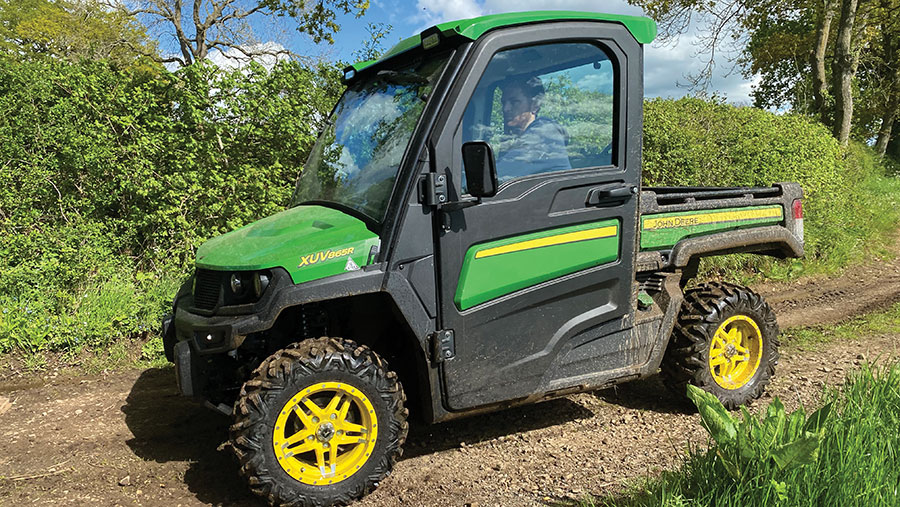 John Deere’s latest Gator is impressively comfortable but rather expensive © James Andrews
John Deere’s latest Gator is impressively comfortable but rather expensive © James Andrews When John Deere launched its 865 Gator at the start of 2020, it looked as though the American giant had intentionally blurred the lines between conventional UTVs and base-spec pickups.
Deere’s R-spec premium package machines promised comfort and sophistication levels never seen before on farm buggies, with luxuries such as air conditioning, electric windows and a pillow-like ride to convince drivers that these once draughty, noisy vehicles have changed their ways.
See also: Off-road vehicle four-wheel drive systems explained
The new cab is the star of the show and it’s the primary feature designers have focused on. Cues have been taken from JD’s other R machines, with quality switchgear, hard-wearing plastics and plenty of sound-deadening material.
Specs
- Engine 854cc Yanmar three-cylinder
- Power 22.8hp
- Transmission Two-speed belt CVT
- Power steering Yes
- Ground clearance 284mm
- Turning circle 8.2m
- Towing capacity 900kg
- Cargo bed capacity 680kg
However, all the pleasantries come at a considerable cost. JD has never been shy of charging a premium for its products, and at £31,181, this test unit sticks unwaveringly to that mantra. We’re told you would be able to see one on farm for about £25,000, but it is still edging into new pickup territory.
Deere was keen to point out that these R-spec versions sell in minimal numbers to farmers, with the cheaper, and frankly more practical, M-spec a popular choice.
These models are similar to the Rs, but they have black interior trim with wipe-clean vinyl seats and come in at about £23,000 on-farm.
Quick verdict
The latest R-spec Gator has undoubtedly set a new benchmark in luxury and ride comfort for other UTVs to match. However, the monstrous price tag is difficult to stomach, especially as practical drawbacks include poor downhill engine braking when loaded and reduced bed space to accommodate the cab.
Price as tested: £31,181
Best for: Ride and cab comfort
Worst for: Engine braking with loaded trailer
Driveline
The Gator’s driveline remains largely unchanged from the older 855M, with a 22.8hp three-cylinder Yanmar engine running through a two-speed belt-driven CVT transmission. It hasn’t lost the sluggish take-off that has long hampered these diesel buggies’ performance, and it demands plenty of engine revs to engage the drive. However, a gearing change means top speed is now a healthier 34mph, rather than the old model’s 28mph, so progress is a little swifter on the road.
Deere has also done some work to limit vibration and noise transfer through the chassis, with the engine now sitting on five rubber mountings.
Gator users will be familiar with the engine braking concept, which requires the drive belt to be engaged for the engine to slow the machine down to avoid freewheeling. Sadly, in our timed downhill braking test, its feathers became a little ruffled.
With a loaded trailer hooked on, it went hurtling down our test hill in a worryingly quick 8sec – compare that with the snail-like Polaris which took 1min 53sec with the same trailer over the same distance. We gave the Deere another shot, but the outcome remained the same.
Previous Gators on test have performed well in that department, so this was a surprise. We can only assume it is down to the higher gearing required to achieve a faster top speed and the additional weight of the new cabin.
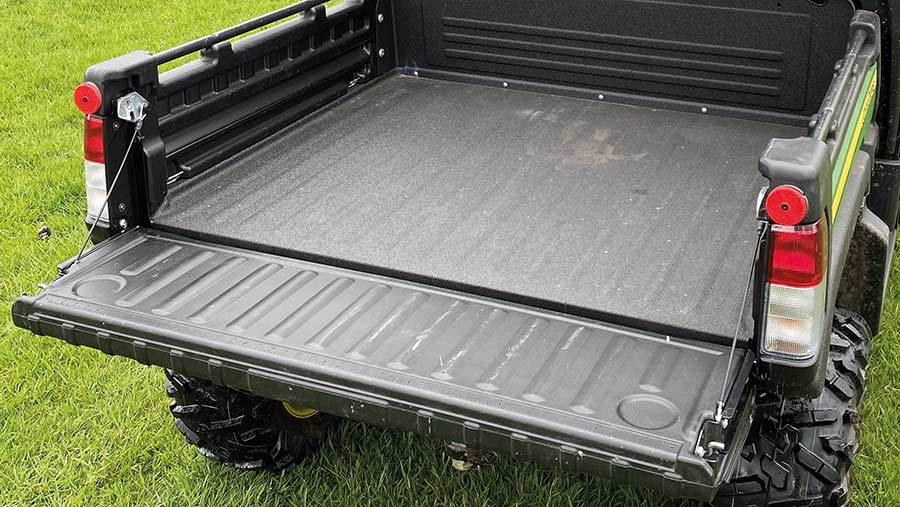
Rear wheels aren’t guarded adequately, so have a habit of flicking dirt up the side of the machine © James Andrews
The park brake arrangement is also less than ideal. With no park position on the gear lever, the only option is to use a small and cumbersome foot pedal with a fiddly pull-style release lever.
The only plus is that the vehicle can be started and left in gear when getting out to open gates, but it is a faff to use. Deere says models ordered now will have a park position incorporated into the gear selector, so the foot pedal won’t need to be used.
Service access is mediocre, partly due to the fact that Deere has fitted the bigger cab onto a chassis it already had. This means jobs such as accessing the battery involve removing the air cleaner and a piece of trim.
Some sections of bodywork are also slightly poor quality, such as the thin rubber straps locking the bonnet down that were no match for the car-like catch on Kubota’s RTV or Corvus Terrain DX4.
Cab
The ace in the Gator’s pack is undoubtedly its cab, which stands head and shoulders above the blustery, raucous cockpits of old. The most noticeable improvement is the sound deadening between the cab and engine – it works wonders and means idle noise registers just 67dBa.
As a comparison, the reading in Kubota’s RTV was 78.5dBa, a figure that the Gator didn’t even reach when towing uphill under load.
Heating and air conditioning blowers direct plenty of air to the occupants, as well as the windscreen, and the well-laid-out switchgear is easy to navigate – although a cheap indicator rocker switch is a slight let-down.
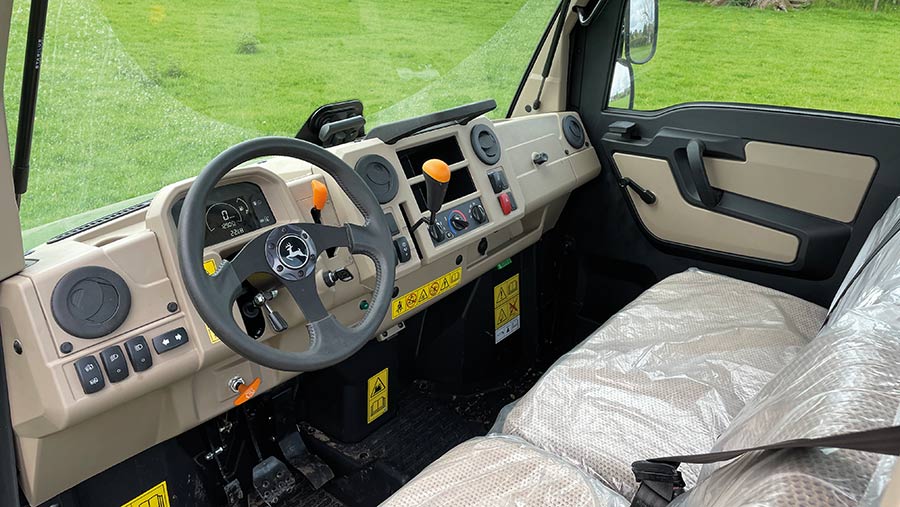
The R-spec cab features a leather steering wheel and air conditioning © James Andrews
The benefits of a large opening window at the front and full-width, wind-down door glass can’t be overestimated. However, the puny gas strut JD has fitted to hold the hefty doors open is a weak spot – the breeze actually caught one of the doors during our testing and the fit wasn’t the same afterwards.
Storage is thankfully plentiful, with drinks holders and cubby holes on the dash, useful door pockets and a passenger bench seat that folds up to allow floor-to-ceiling storage for oil drums or other bulky items. The driver is also treated to heaps more floor space for the left foot – this was a common gripe on Gators of old, with the wheel arch protruding in.
Although plush, the cabin is far from workaday. Cloth-covered seats, a leather steering wheel and a beige dash and headlining are all nice to look at, but have little chance against the rigours of a modern farm. A better bet is the M-spec, which gets vinyl seats, black dashboard and harder-wearing roof lining.
Working life
Towing capacity is ample at 900kg, but a gripe when hitching up trailers on our test model was a backbreaking stretch to reach the ball tucked way under the rear bed – this caused plenty of huffing and puffing when slotting the hitch onto it. Taking up Deere’s extendable option or getting one made would be a worthwhile investment.
Suspension travel on the Gator won’t be the clincher in any deal either, as it only offers 200mm on the front – the lowest of our test group – and 231mm on the rear. However, what it lacks in travel it makes up for in tuning, as it glides along rutted tracks at speed with the occupants experiencing little more than a wobble.
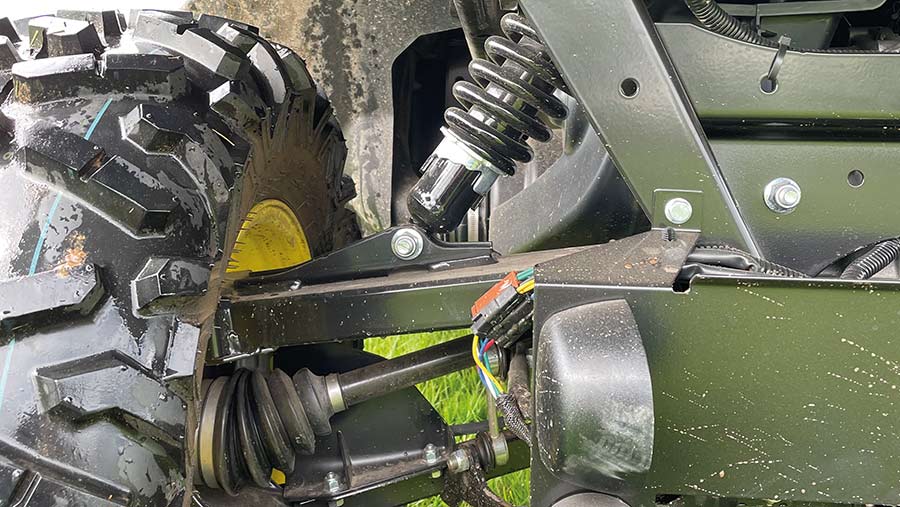
Suspension is well tuned, which more than makes up for a slight lack of travel © James Andrews
The load bed doesn’t appear to have changed for years and still has the best depth of any on test, pipped in length only by the cavernous Corvus. It can still hold the most weight, too, at 680kg, but the rear window and roof have been sloped rearwards and protrude into the bed’s height. This will likely hamper anyone trying to load an IBC or round bale.
It was also lacking decent mudguards to protect the cab and cargo bed from getting caked in mud. At the end of testing, it was the dirtiest machine by some margin. A wider bed or set of rear mudguards would help solve this problem.
Another downer was some exposed wiring near the wheels for trailer connections and rear lights, which is very unlike Deere. This could do with tidying up to keep the crud out and help the electrics last a little longer.
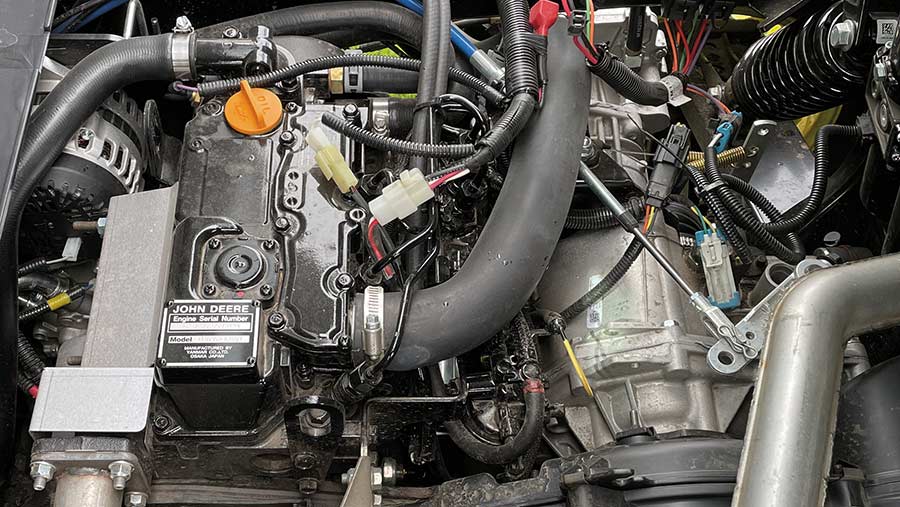
Access to the engine under the tipping back is pretty good © James Andrews
Likes and gripes
Likes
- Supremely comfortable on rough ground
- Quiet cab, even at full speed
- Biggest payload
Gripes
- Poor downhill engine braking with a full trailer
- Small bed lets mud cover rear of cab
- No park position on the gearstick

